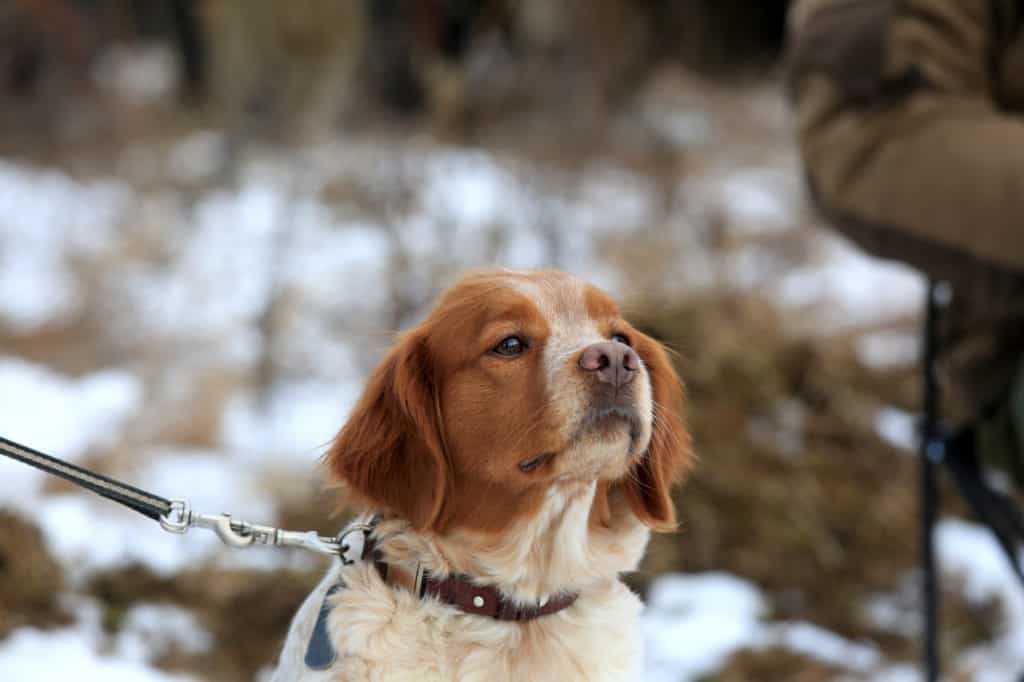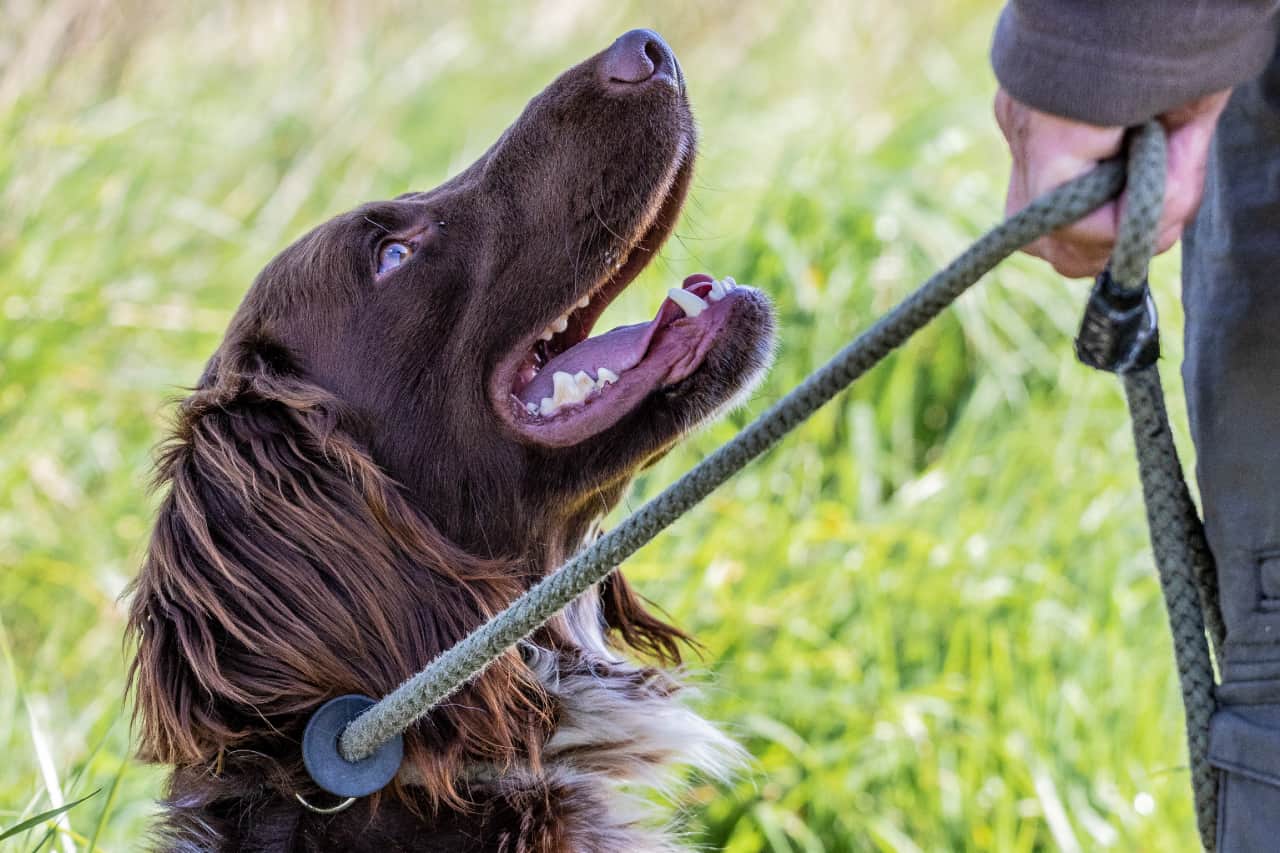A slip lead looks like a regular lead, but it has a metal ring on one end instead of a clip for a collar. The lead is pulled through the ring to form a noose that goes over the dog’s head. Straining against the lead tightens the loop around the dog’s neck, and there is a danger of strangulation.
You can use a slip lead on a puppy, but many people don’t recommend it because pups tend to pull more. They have delicate, slender necks and have yet to develop strong neck muscles. Their throats are soft and easily damaged. If misused, the choking sensation as it tightens may traumatize your puppy.
A slip lead must be put on the right way round and must not be pulled too tight. It is effectively both a leash and a collar and is called a slip lead because it slips over the dog’s head. It is made of nylon, cotton, or leather and should not be confused with a choke chain.
What Is The Best Leash For A Puppy?
Different types of leashes have their uses, and the kind of dog they are used for must also be taken into account. Adult dogs usually have more muscular necks than puppies, and the slip leash is often the tool of choice for hunting dogs and showing dogs in the show ring. Even the adults of small breeds, however, can have delicate necks that can be easily injured.
When you are training a puppy, the experience should be fun for both of you. A puppy should never be pulled around by its neck with any type of leash or collar. Slip leads, pinch collars, and choke chains can cause pain and distress and may put a puppy off training entirely.
If your puppy is a pug, Boston terrier, greyhound, or whippet, with a neck that is as thick as its head, a regular collar or a slip lead might not be suitable. Slip leads are designed to be taken off and put on quickly, and your pup might be able to back out of it. In this case, a chest harness with a back clip may be more appropriate and, as an added bonus, will not pull on your dog’s neck.
A puppy’s first collar and leash should be lightweight and must not put unnecessary pressure on the spine. Large dog breeds have larger puppies, so the leash should be light but strong. The lead must also be long enough to allow the puppy to walk freely with it attached.
Your pup is more likely to pull against a leash that is too short. Stretchy or retractable leads are not recommended for training a puppy because they don’t give you much control. In fact, most dog trainers hate them because they actively encourage the dog to pull.
While you should never suddenly yank a puppy by the leash, you must be able to pull it gently in the right direction.
The leash should be six feet long to provide freedom of movement while at the same time restraining puppyish exuberance. The collar should be adjustable and can be made of nylon or leather, or even cotton but shouldn’t be too wide or too tight around the dog’s neck. If you can slip two fingers between the collar and the neck, it fits properly.
When Is It Appropriate To Use A Slip Lead?
Many people only recommend using a slip lead on adult dogs who have already been trained to walk on a leash. Puppies have not yet acquired this skill and are much more likely to jump and pull. Ideally, you should use a flat collar and a traditional leash with a clip when training a puppy to walk on a leash.
Dog trainers sometimes recommend a Martingale collar as a safer alternative to a standard slip lead or flat collar. It consists of a small loop linked to a larger loop. The larger loop goes over the dog’s head, and the leash is attached to the smaller loop.
When the dog pulls, the loop around its neck tightens only enough to prevent it from slipping out of the collar but not enough to choke it. However, these collars must not be worn when the dog is unsupervised and are not recommended for training puppies. Martingale collars are sometimes used for sighthounds and other hunting dogs.
Slip leads are not intended for everyday use in dog walking or dog training. They are used in dog shows to parade the dog around the ring for the judges. In this context, their use is brief, and the dog is not really going for a good walk.

When Should You Leash Train A Puppy?
A puppy needs time to get used to wearing a collar and leash, and you should wait until he is around eight weeks old before putting one on. The pup should be allowed to smell the collar and be given a treat afterward so that he associates it with something good. At first, the puppy should only wear the collar for a few minutes before you take it off again.
Gradually leave the collar on for longer and longer periods and give him treats whenever he allows you to put it on. Puppies grow fast, so be sure to buy a collar that can be adjusted as his neck size increases.
Only when the puppy is comfortable with the collar should you attach the leash. At first, let him walk around a little bit inside with the leash dragging on the floor. Then take hold of the leash and encourage him to walk towards you with praise and treats.
Puppies have a short attention span so spend only a few minutes every day putting him on the leash and calling him to come to you. The next step is to get him to follow you while wearing the leash as you slowly walk around the room. Never force him or drag him.
When first walking your puppy outside, keep walks short and don’t let him get too exhausted. Gently redirect him with warm words and treats when he gets distracted. The idea is to get him loose leash walking eventually. Loose leash walking is when the dog and the owner walk together in a relaxed manner without the dog continually straining on the leash.
If your puppy suddenly starts pulling forwards against the leash, stop walking and stand still. Don’t move until he stops pulling and comes back to you. Try to anticipate lunging by distracting him with a treat under his nose. Never be impatient or use a harsh tone of voice.
Slip Leads Are Only For Temporary Use
Animal shelters and rescue workers often use sturdy slip leads made of rope or nylon. By contrast, those used in show rings are usually made of lightweight leather, nylon, or thin chains. No matter what they are made of, their function is the same, and they have the potential to damage the dog’s trachea if it pulls hard and persistently or they are put on the wrong way around.
Slip leads are convenient to use in the show ring and when rescuing stray dogs because they are easy to take off and put on. However, in both cases, the lead only stays on for short periods. For more extended periods, like going on dog walks or during training classes, slip leads are not recommended.
Many people ask why you would even want to use one when there are other safer alternatives.
You can use a slip lead to train an adult dog having difficulty learning to walk without pulling or when you need to hold his attention. The slip lead should always be just behind the dog’s ears and under his chin so that you can gently correct him. Never position the lead over the windpipe or pull hard on it.
Conclusions
Different leashes are used in various settings for various purposes. The size and shape of the dog also determine which tool is the most appropriate. Puppies should not be trained on slip leads because the risk of injury is too high when they are so young. Many people don’t know how to put a slip leash on correctly and end up choking the dog.


